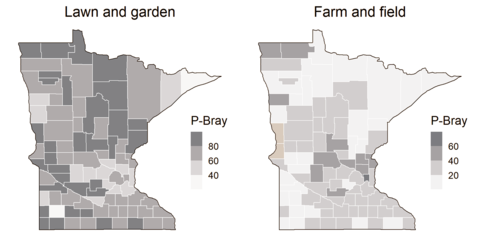Do we over-fertilize our gardens?
An analysis of soil tests completed at the University of Minnesota soil lab between 1988 and 2021 revealed that many Minnesota lawns and gardens have much more phosphorus than they need. The median statewide soil phosphorus reading was 68 ppm (Bray) for lawns and gardens, compared to only 26 ppm (Bray) in farm fields (Bray is one method to extract phosphorus in soils with a pH of 7.4 or less. Some Minnesota soil tests may report phosphorus levels using the Olson extraction method if the soil pH is more than 7.4).
A reading of 20 ppm is considered sufficient for growing vegetables, and more than sufficient for lawns. In general, using too much phosphorus is a problem for water quality, and over-fertilizing is expensive. At high enough rates, it can also negatively impact plant growth.
Does it matter?
Over-fertilizing lawns and gardens matters for a variety of reasons. When there is excess phosphorus in the environment, it can leach into lakes and rivers, causing toxic algal blooms. A 2019 study by Gaston Small and colleagues at the University of St. Thomas found that in the Capitol Region Watershed (Twin Cities), urban gardens make up only 0.1% of the land area, yet they contribute up to 19% of the phosphorus inputs to urban soils. The average phosphorus reading in their study was 80 ppm (Bray), just over the statewide median for lawns and gardens.
Fertilizers, composts, and other soil additives can also be expensive and they take time to apply, so cutting back can save time and money.
What can we do about it?
- Take a soil test from your lawn or garden every few years. Download a form and find instructions from the soil testing lab site.
- If your soil phosphorus levels are above 25 (Bray test) or 18 (Olsen test), do not use a phosphorus-containing fertilizer for a few years, until your levels drop to a point where your soil test recommends more phosphorus. Keep in mind that compost often contains phosphorus, especially if it contains manure.
- If you have enough phosphorus in your garden but still need nitrogen or potassium, consider options like feather meal or blood meal (nitrogen), and potassium sulfate or langbeinite (potassium). These products will not contribute excess phosphorus.
- If you add a thick layer of compost to your garden each year, consider your compost as a source of nutrients. Usually, compost has low nutrient concentrations, but when used in large volumes, or when using manure-based composts, the nutrient contributions can add up.
- Consider using cover crops in your garden. They can provide nitrogen and they build your soil health without adding extra phosphorus to your soil.
- Learn more about soil health for gardeners and visit UMN Extension Yard and Garden YouTube channel.
Small, G., Shrestha, P., Metson, G.S., Polsky, K., Jimenez, I., Kay, A. 2019. Excess phosphorus from compost applications in urban gardens creates potential pollution hotspots. Environmental Research Communications 1(2019)091007. https://iopscience.iop.org/article/10.1088/2515-7620/ab3b8c/meta


